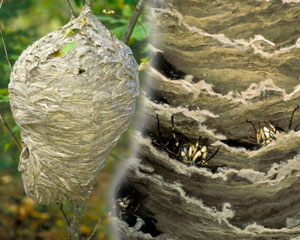
By Dan Zarlenga, Missouri Department of Conservation
Take a walk into the woods this time of year, and you’re likely to be greeted with leafless trees arrayed with bare, gangly, limbs. While some might see no need to look closer, if you do look, you might discover an amazing piece of natural paper art, rivaling the most creative origami humans could ever fashion. The downed leaves could reveal a ghostly, gray bald-faced hornet nest hanging from a barren branch.
The bald-faced hornet is actually a species of wasp, recognized by the white markings on its face and thorax, and at the end of the abdomen. This is where the “bald” in the name comes from, perhaps referring to the word’s middle English meaning of white. The rest of their bodies are black. Bald-faced hornets are the artists who spin the delicate, yet durable, works of art.
Bald-faced hornets are extremely social creatures, and all individuals have highly specialized jobs that serve the entire colony. A single insect of the group could never survive on its own; all the individuals function as a giant, single organism, as if each was one part of a whole body.
The colony is started in the Spring by a queen. She lays eggs and rears hundreds of female workers from the larvae. These workers tend to nest making duties so the queen can continue her all-important egg laying. When winter begins to close in, the queen lays eggs that will hatch male drones and new queens. Mating occurs just before temperatures take a dive and most of the colony dies off, leaving only fertilized queens to carry on next season. The queens will overwinter in a safe place like a hollow tree trunk.
While bald-faced hornets can fiercely defend their nest, each one stinging a perceived intruder multiple times, the nests are mostly made high in trees, away from people. Separated from the nest, bald-faced hornets are not aggressive. Since they feed on plant nectar, these insects are one of our helpful pollinators.
They also are amazing at creating their nests. These industrious wasps chew wood and combine it with starches in their saliva. This process creates wood pulp, a form of paper, and this is what bald-faced hornets use to make their nests. They are built from several layers of horizontal comb structures enclosed by an outer envelope. The complex array of innumerable combs, provide protection for the queen and growing larvae. Even though made of paper, the nests are surprisingly resilient to wind, rain, and other destructive weather.
After the first frost, it should be safe to approach the abandoned nest. If you wish to retrieve and study its intricacies, consider wrapping the nest in a plastic bag and freezing it for a few days.
People sometimes display bald-faced hornets’ nests as decorations. Their surreal gray color, and intricate swirls of paper certainly make great conservation starters. Be sure to remind your guests that they are looking at a work of insect art, inspired by nature’s ability to creatively rise to the challenges of survival. www.mdc.mo.gov


